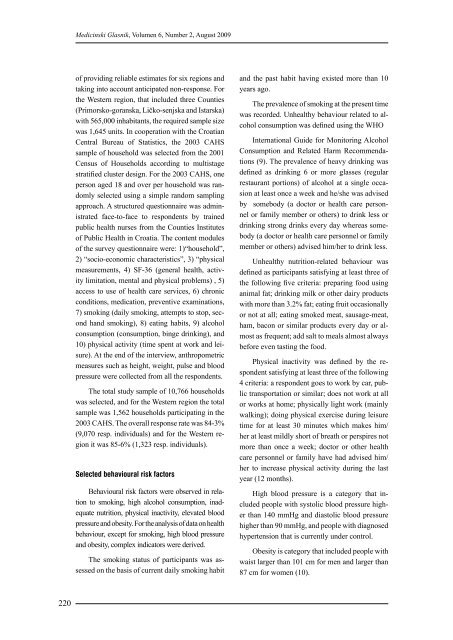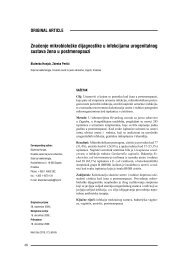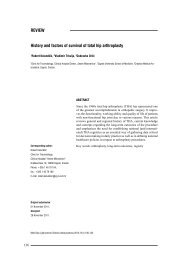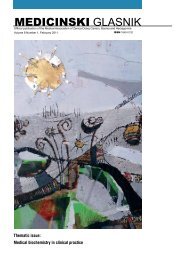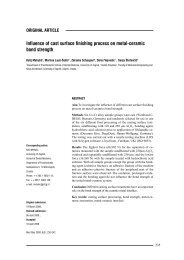MEDICINSKI GLASNIK
MEDICINSKI GLASNIK
MEDICINSKI GLASNIK
You also want an ePaper? Increase the reach of your titles
YUMPU automatically turns print PDFs into web optimized ePapers that Google loves.
220<br />
Medicinski Glasnik, Volumen 6, Number 2, August 2009<br />
of providing reliable estimates for six regions and<br />
taking into account anticipated non-response. For<br />
the Western region, that included three Counties<br />
(Primorsko-goranska, Ličko-senjska and Istarska)<br />
with 565,000 inhabitants, the required sample size<br />
was 1,645 units. In cooperation with the Croatian<br />
Central Bureau of Statistics, the 2003 CAHS<br />
sample of household was selected from the 2001<br />
Census of Households according to multistage<br />
stratified cluster design. For the 2003 CAHS, one<br />
person aged 18 and over per household was randomly<br />
selected using a simple random sampling<br />
approach. A structured questionnaire was administrated<br />
face-to-face to respondents by trained<br />
public health nurses from the Counties Institutes<br />
of Public Health in Croatia. The content modules<br />
of the survey questionnaire were: 1)“household”,<br />
2) “socio-economic characteristics”, 3) “physical<br />
measurements, 4) SF-36 (general health, activity<br />
limitation, mental and physical problems) , 5)<br />
access to use of health care services, 6) chronic<br />
conditions, medication, preventive examinations,<br />
7) smoking (daily smoking, attempts to stop, second<br />
hand smoking), 8) eating habits, 9) alcohol<br />
consumption (consumption, binge drinking), and<br />
10) physical activity (time spent at work and leisure).<br />
At the end of the interview, anthropometric<br />
measures such as height, weight, pulse and blood<br />
pressure were collected from all the respondents.<br />
The total study sample of 10,766 households<br />
was selected, and for the Western region the total<br />
sample was 1,562 households participating in the<br />
2003 CAHS. The overall response rate was 84-3%<br />
(9,070 resp. individuals) and for the Western region<br />
it was 85-6% (1,323 resp. individuals).<br />
Selected behavioural risk factors<br />
Behavioural risk factors were observed in relation<br />
to smoking, high alcohol consumption, inadequate<br />
nutrition, physical inactivity, elevated blood<br />
pressure and obesity. For the analysis of data on health<br />
behaviour, except for smoking, high blood pressure<br />
and obesity, complex indicators were derived.<br />
The smoking status of participants was assessed<br />
on the basis of current daily smoking habit<br />
and the past habit having existed more than 10<br />
years ago.<br />
The prevalence of smoking at the present time<br />
was recorded. Unhealthy behaviour related to alcohol<br />
consumption was defined using the WHO<br />
International Guide for Monitoring Alcohol<br />
Consumption and Related Harm Recommendations<br />
(9). The prevalence of heavy drinking was<br />
defined as drinking 6 or more glasses (regular<br />
restaurant portions) of alcohol at a single occasion<br />
at least once a week and he/she was advised<br />
by somebody (a doctor or health care personnel<br />
or family member or others) to drink less or<br />
drinking strong drinks every day whereas somebody<br />
(a doctor or health care personnel or family<br />
member or others) advised him/her to drink less.<br />
Unhealthy nutrition-related behaviour was<br />
defined as participants satisfying at least three of<br />
the following five criteria: preparing food using<br />
animal fat; drinking milk or other dairy products<br />
with more than 3.2% fat; eating fruit occasionally<br />
or not at all; eating smoked meat, sausage-meat,<br />
ham, bacon or similar products every day or almost<br />
as frequent; add salt to meals almost always<br />
before even tasting the food.<br />
Physical inactivity was defined by the respondent<br />
satisfying at least three of the following<br />
4 criteria: a respondent goes to work by car, public<br />
transportation or similar; does not work at all<br />
or works at home; physically light work (mainly<br />
walking); doing physical exercise during leisure<br />
time for at least 30 minutes which makes him/<br />
her at least mildly short of breath or perspires not<br />
more than once a week; doctor or other health<br />
care personnel or family have had advised him/<br />
her to increase physical activity during the last<br />
year (12 months).<br />
High blood pressure is a category that included<br />
people with systolic blood pressure higher<br />
than 140 mmHg and diastolic blood pressure<br />
higher than 90 mmHg, and people with diagnosed<br />
hypertension that is currently under control.<br />
Obesity is category that included people with<br />
waist larger than 101 cm for men and larger than<br />
87 cm for women (10).


